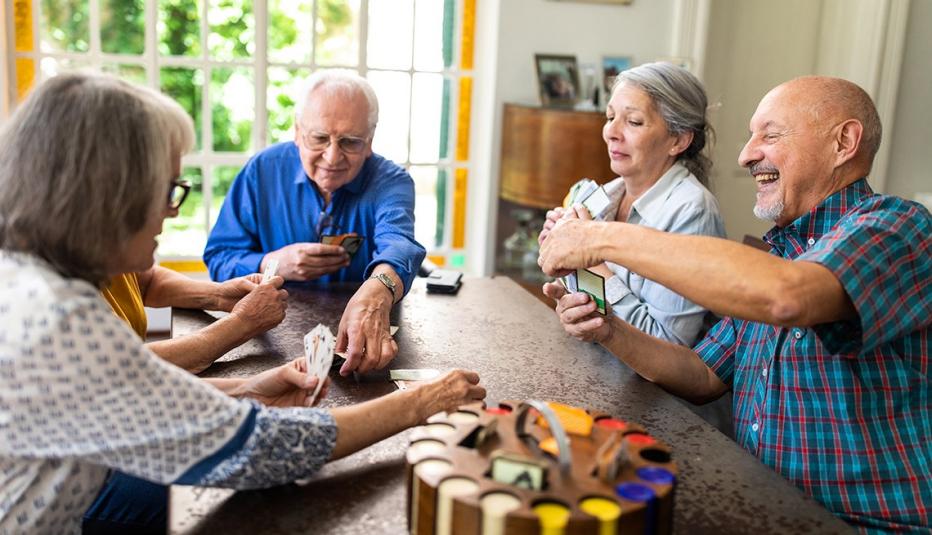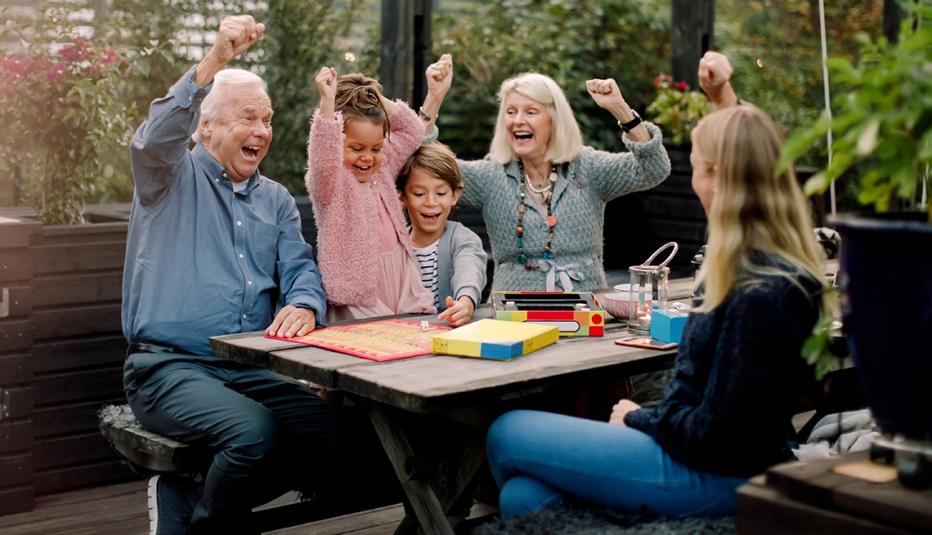AARP Hearing Center
Let’s face it. Family gatherings are not often at the top of the list of kids’ favorite activities. Many kids - not to mention their parents and grandparents - spend more time behind their smartphones than interacting with their family. They are chatting on social media, sharing media with their friends, and playing games. Today’s families are simultaneously more connected and disconnected than we have ever been, and cultural generation gaps tend to be bigger than ever. Thankfully, there’s one neat trick you can use to bridge that gap: Video games.


Playing Together Beyond Competition
To some readers, this might seem like a strange proposition. After all, interviews with avid older players [1] reveal that while most people don’t mind playing across age barriers, games tend to be the most fun when players have shared interests and their in-game skill levels are roughly the same. These are both elements that are easier to find when age gaps aren’t too large.
For competition-minded players, this makes a lot of sense, and it might explain why according to a study by AARP Research [2] only 5% of 50+ year-olds prefer to play with children under the age of 18. However, there is a lot more to gaming these days than just competitive challenges. Consider for instance an anecdote in a study on player motivation across generations [3]. It illustrates the value of intergenerational play, through an endearing story about a son whose mother eventually joined him in playing Animal Crossing. After she passed away, he wrote the following on a blog:
I had forgotten about Animal Crossing, I hadn’t played it in over a year and a half. Today, however, I decided to visit the village in the game again and see what was up. I came to my mailbox, it was full of letters with presents—all from my mom. Every letter was pretty much the same. ‘‘Thinking of you. Thought you’d like this present. Love, Mom.’’ Even though I’d stopped playing, she continued to send me presents. I look back now at how I made fun of her for playing even after she’d done everything, and I realize now that she was probably spending her time getting presents for me.
While it might not always be visible from the surface, modern games are more than arenas to play out our rivalries. They are cultural spaces where people can live substantial parts of their lives, and by extension, they are places that can be shared with those for whom we care. It brings us closer together, which not only feels good, but actually is good for us. Whether There is a lot of research that confirms the benefits of playing games socially, but in a nutshell, scientists have found that games can improve socio-emotional well-being and decrease loneliness [4], including for those who play across generations with their family members [5].
Leapfroggers and Empty Nesters
Considering the research, there are many reasons to try to get some “intergenerational play” going between yourself and your loved ones, and there are many games and ways to play together. As the examples below will demonstrate, games offer something for everyone.
A very common way to play across generations is called “Leapfrogging” [6], a term that refers to older players that skip a generation by playing with their grandchildren; by contrast, their typically adult children prefer different kinds of games or different platforms and are happy to take a break from parenting their children as they play with their grandparents.
The key to a good leapfrog game lies in its interest and accessibility to a wide age range, while accommodating different skill levels and cultures, as there are often many individual differences between players. Some players prefer slow and deliberate experiences, while others excel at exciting twitch-speed gaming. Similarly, some like games that are rooted in prior knowledge and experience, while others want dexterity-based games. To accommodate differences across generations, skill and experience disparities need to be resolved.
One way to resolve skill disparities is “vicarious play” [7]. This collaborative form of play occurs when one player operates the controls of the game, but players discuss moves and choices together Some genres that lend themselves well to this style of play are traditional point and click adventures (such as Day of the Tentacle (Remastered), Machinarium, Myst or the Nancy Drew series) and action-adventure games (such as the Legend of Zelda series or the Uncharted series), but really any game allows for this shared experience. There are even games designed around this concept, such as Keep Talking and Nobody Explodes, a game in which one player has to defuse a ticking timebomb without having any knowledge of which wires to cut or which codes to enter, while the other player cannot see the bomb but has the defusion manual in front of them. Communication is the key to beating the game.
Online gameplay is another way that many parents stay in touch with adult children [8]. Between busy agendas and schedules, we all need time to relax and take a break. For many adults nowadays, that means playing games. Massively multiplayer online games (of which World of Warcraft is still the most popular example) can provide a wonderful shared activity to engage in with adult children, as well as smaller independent games, such as Pirates of the Burning Seas, or the superhero-themed City of Heroes. Or if games with millions of other players online are not your cup of tea, then perhaps its worth considering an online real-time strategy game like the Civilization series, where you manage and build an entire civilization that can stand the test of time, or a cooperative online game with a richly detailed fantasy world on par with any movie, such as Divinity: Original Sin 2. Research also indicates that non-game virtual worlds, with affordances for creative actvity, have greater appeal at the higher end of the age spectrum (Pearce VW study 2012)
For creatively inclined players and hobbyists who want to engage with younger family members, Minecraft is an appealing way to connect with family members across all ages. Best described as “digital Lego,” the game has a building mode which allows for broad possibilities. It crosses the spectrum for younger children, to adults, and has become popular among 50+ year-old streamers [9].
Livening up the Family Get-Together
Finally, we find ourselves back at where we started. If everyone is sitting around on their phones for a planned family gathering, then why not start there? There are many party games that will have everyone in your family engaged, laughing and enjoying themselves.
Heads Up! is a fun world game where you place your phone on your forehead while other players give you hints to guess the word. Or, network your phones together and play a collaborative game like SpaceTeam, where you yell spaceship controls at each other, or Blabyrinth, a cooperative escape-room style game. Try a party game like the ones found in the Jackbox series, or, if you happen to have a Nintendo Wii or Switch, we can’t count how many research participants have told us their grandparents kicked their you-know-what's at Wii/Switch Bowling (or any of the Wii/Switch Sports). A single-screen game like Bloop, best described as “twister for your fingers,” or the digital adaptation of the classic card game Set work well for younger players. If it’s a nice day, why not go outside as a family to play Pokémon Go, the highly popular pervasive augmented reality game where you hunt for the adorable eponymous monsters?
All you have to do is ask
No matter who you are, what context you are looking to play in, or even what your skill level and experience with games are, there is a game out there that can help you to bridge generational gaps. The most important thing is to gently ask. If you see your younger relatives playing a game, look for an opportunity to sit down with them and to ask them what they’re playing. If you’re exploring a new game, ask for help on a puzzle or advice on what your character should do next. It’s only a small step, but - as long as everybody is motivated to give it a try - it will open the door to meaningful shared experiences that your family will cherish forever.
Dr. Bob De Schutter
Dr. Celia Pearce
Games for Life Center
Northeastern University
Dr. Bob De Schutter – Bob is an Associate Professor of Game Design at Northeastern University. He has specialized in researching play in relation to aging since 2004, and he is also the owner of independent game development studio Lifelong Games.
Dr. Celia Pearce – Celia is a Full Professor at Northeastern University. She is a game designer, author, researcher, teacher, curator, and artist, specializing in multiplayer gaming and virtual worlds, independent art, and alternative game genres. Her recent work focuses on live action roleplaying and “playable theatre.” She is also the co-founder of IndieCade, and is considered a leader in games and diversity..
Endnote
Unless indicated otherwise, the authors are not affiliated with the developers or publishers of any of the games mentioned. Please review any example’s content on a parental review site prior to playing them with younger generations, as some games might contain content that are not suitable for young children or teens.



































































